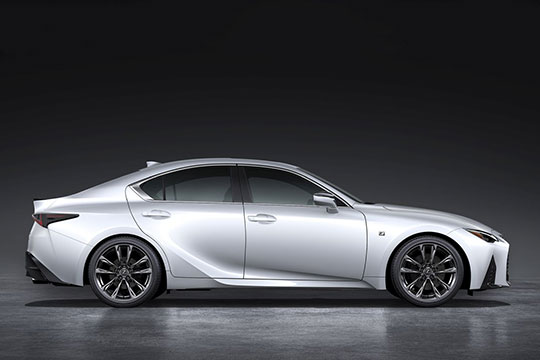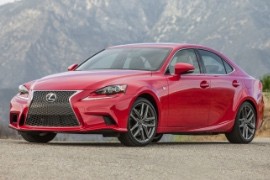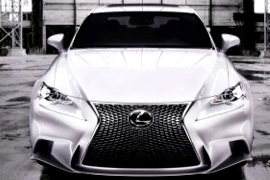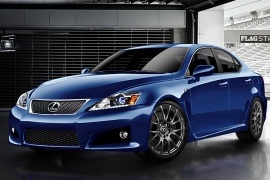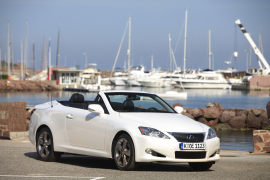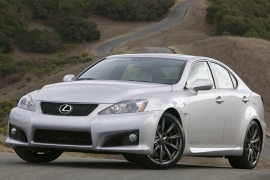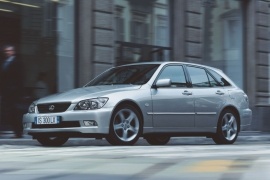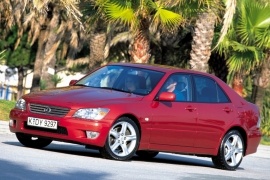LEXUS IS Models/Series Timeline, Specifications & Photos
First production year: 1998
Engines: Gasoline, Hybrid, Hybrid gasoline, Diesel
Lexus introduced the last update for the third generation of the IS range in 2020. It was a mandatory revamp of its compact sedan, to keep its sales figure up in a harsh market hit by the world pandemic.
When Toyota decided to build a car to compete against the BMW 3-Series in 1998, the world looked amused at them. But from the second generation, the IS became a real competitor for the German brand.
The last update for the IS brought a new image for the car. The designers installed new headlights and the spindle grille, which was in line with the Lexus range's aesthetic trend. The car was lower and wider than the non-facelifted version, due to its enlarged fenders. On its sides, the IS featured a new design for the sills that amplified the vehicle's muscular profile.
Lexus prepared a new infotainment unit for the restyled interior that featured Apple CarPlay and Android Auto connectivity. The 8" touch-screen was fitted as standard, while a 10.3" unit was available as an option. Depending on the trim level, Lexus offered sport seats, leather upholstery, or simple, high-quality coth.
Lexus offered three engine choices, with either a turbocharged inline-four or two V6 units. The base model featured a rear-wheel-drive architecture while the V6 versions were offered with an all-wheel-drive system and a Torsen limited-slip rear differential. All versions were paired as standard to an 8-speed automatic.
The third generation of the Lexus IS was introduced in 2013, and the Japanese carmaker refreshed it in 2016.
Lexus introduced the IS range in 1998 as a sport compact car aimed at the German BMW 3-Series and the Mercedes-Benz C-Class. While in the beginning, it wasn't a true match for them. Later on, it started to increase its image and performance. By the third generation's facelift, another two important competitors were added to the list: Audi and Jaguar.
The designers worked a little at the grille at the front and changed the horizontal slats from the non-facelifted version to a mesh-grille. Its lower part of the bumper was reshaped and featured side-pods to cool the front brakes. But that's where they stopped with the exterior changes.
Inside, there were more differences, especially in the instrument cluster. Starting with 2016, the IS featured a more advanced display, with a center rev-counter and additional gauges placed next to it. The onboard computer information was shown inside the tachometer's dial. Another improvement was for the infotainment system, where Lexus installed a high-resolution display fitted as standard. A navigation system and a 15-speakers Mark&Levinson Premium sound system was on the options list. It was Apple CarPlay compatible.
Under the hood, Lexus introduced new technologies, new engines, and more performance. Like its non-facelifted version, it didn't feature any diesel unit. Its base model was powered by a 2.0-liter turbocharged four-pot available with rear or all-wheel-drive. The carmaker axed the 2.5-liter V6, and the only six-cylinder version was the 3.5-liter unit, which kept the same output.
Lexus introduced the third generation of the IS at the 2013 North American International Auto Show and focused on the sporty side of the premium compact sedan segment.
BMW's most successful lineup in those times was the 3 Series, and Mercedes-Benz challenged them with the C-Class while Audi's answer was the A4. In the American corner, Cadillac confronted them with the CTS, even though that was larger. Moreover, just a few months after the IS' unveiling, Caddy introduced a third generation of the CTS that was even larger.
From the design point of view, Lexus adopted the spindle grille on the IS, and customers were not very pleased with the car's new look. Still, the dynamic shape of the vehicle with swept-back, angular headlights made it very aggressive. In addition, the vehicle's profile revealed an ascending beltline underlined by an arched-up sculptured one on the side sills. Finally, at the back, the wide taillights crossed the border from the quarter panels to the trunk's lid.
The interior was clearly divided between the driver's area and the side passenger by a tall center console that hosted two cup holders, a storage compartment, and the gear selector. In addition, on the passenger's side, the automaker placed the controller for the infotainment system. In the dashboard, the speedometer took center stage with its digital numbers and was surrounded by the tachometer. The high-bolstered seats were designed to keep their occupants in place during high-speed cornering. At the back, the IS offered limited legroom for two passengers, while a third one had to deal with the tall transmission tunnel.
Under the hood, Lexus installed a choice of three powertrains, either gasoline-only or hybrid. The latter was based on the same Atkinson-cycle powerplant offered in the RAV4 and an electric motor.
In September 2013 Lexus announced the introduction of 2014 IS F top performer. With a V8 under the hood and on-track development, the car was a fast, on-road, best.
Lexus IS was launched in 1998 and ever since it was the model that constantly received a sport version. It also was the first Lexus model to receive the "F" letter for the performance model. When the ISF was introduced, it was meant to compete with the likes of the BMW M3 and the AMG C-Class.
From the first look, it was obvious that the F model was not the regular IS. A larger air-intake in the front bumper and side exhaust vents on the front fenders raised suspicions regarding what's beneath the skin. The hood was bumped-up like the horses under the hood were ready to jump out of there. In the rear, there was a discreet lip-spoiler on the trunk, and the quad pipes exhaust that were there for a reason.
Inside, there were sport-bucket seats with high bolster support. The lower part of the steering wheel was covered with blue leather and the F-logo The same logo was found on the seats, with contrast stitching. The carbon-fiber decoration on the center console between the front was the final detail that told the difference.
Under the hood, there was a 5.0-liter V8 engine. It was mated to an 8-speed automatic gearbox only that allowed manual gearchanges via two paddle shifters behind the steering wheel.
Lexus introduced the open-top version of the IS range at the 2008 Paris Motor Show. Despite the bad timing due to the world financial crisis, it managed to survive until its replacement arrived in 2014.
The Japanese carmaker tried to take a slice of the European premium car market. Thus, Lexus tried to hit the competition in the convertible segment with a retractable hard-top vehicle, which neither of its competitors had. And thus, the IS C was born. Unfortunately for Toyota's premium brand, it was bad timing.
Lexus' designers made a similar front fascia for the convertible version of the four-door IS, following the new-edge design language with sharp, rounded lines and curved panels. Between the narrowed headlights, the carmaker installed a waterfall-style chromed grille that sported the L-badge in the middle. From its profile, any resemblance between the convertible and the sedan stopped. The retractable hard-top could have been open or closed in just 20 seconds, which was remarkable for a four-seat vehicle. There were no fewer than 15 motors and 35 sensors involved in that movement.
The carmaker found a way to squeeze four seats inside the cockpit, even though those placed behind were mostly useless. Due to the retractable roof, the carmaker had to move the back seats forward, leading to minimal legroom for the rear passengers. The dashboard sported the same design as its four-door sibling. Lexus tried to make a stand in the segment and provided the IS C with a leather-wrapped interior. Moreover, it added more features as standard.
Under the hood, Lexus installed a choice of two engines, both with six cylinders. They did provide similar power as its main competitors, but there were only two, which didn't help Lexus' sales department.
Unlike the luxurious vehicles that Lexus used us with, the IS-F was built to compete with cars such as Audi RS4, BMW M3 and Mercedes-Benz C63 AMG.
Sure, that doesn’t mean that luxury was left aside. However, the Lexus’ F line was long forgotten with their first attempt back in the 80’s.
Lexus had to go great lengths to differentiate the IS-F from the IS sedan, and it was not only the new power plant that was fitted. The hood had to be redesigned to accommodate the bigger engine.
The IS-F was available in a single trim level that featured 19-inch alloys, Brembo brakes, heated and sport seats with leather upholstery, xenon headlights, dual-zone automatic climate control, keyless ignition and entry, a moonroof and a 13-speaker sound system.
Stand-alone available options included an upgraded 14-speak audio system, iPod integrations, park assist, back-up camera, Bluetooth connectivity and adaptive cruise control.
The IS-F was driven by a 5.0-liter V8 engine that generated 416 hp and 371 lb.-ft of torque. The power was sent to the rear wheels through an 8-speed automatic transmission.
Safety wise, the IS-F was equipped with antilock brakes, front-seat knee, side and full-length head curtain airbags as standard, as well as an optional pre-collision system that controlled the seatbelt tension and the braking force.
The second generation of the Lexus IS was introduced in March 2005 at the Geneva Motor Show. It was aimed directly at the premium sedans such as the BMW 3-Series and the Mercedes-Benz C-Class.
With the 2005 model, the IS tried to get a bigger slice of the market. Toyota's premium brand came with a long list of standard features even for the base model, which featured Bluetooth connectivity and engine start button. The IS was built on the Toyota N platform, which was used for rear- or all-wheel-drive vehicles.
The exterior was designed in a Japanese style, with a mix of curved and angular shapes. The front area looked like it was swept-back with all of its elements, starting with the trapezoidal grille, and continued with the headlights. The ascending beltline was ended to the taillights.
The Interior of the Lexus IS was not as inspired in terms of design as the exterior. There was nothing wrong with its look, but nothing appealing either. The seating position in the front seats was higher than in a BMW 3-Series. In the back, there was room for two adults. The massive transmission tunnel was too big to comfortably accommodate a third person. The rear bench seatback could not be folded to extend the trunk, which was not as big as its competitors.
For the engine side, the IS was introduced with a choice of two gasoline units. Later on, there were more options available, including a 2.2-liter diesel for the European market. A 6-speed manual was fitted as standard for most of the range and a 6-speed automatic was available as an option.
Lexus rocked the BMW 3 Series and Mercedes-Benz C-Class thrones when it introduced the IS Series in 1998, and then, in 2000, it tried to do the same with their station wagon siblings.
Unlike its main rivals, Lexus named the five-door version "Sport Cross" since it was halfway between a hatchback and a station wagon. Still, it provided more trunk than its three-box sedan version, but it traded some space for the overall look.
From the outside, the IS Sport Cross featured the same front fascia as the four-door version. The big difference was on the sides and rear, where the carmaker extended the roof behind the C-pillars and placed an additional side window. At the back, the IS 200 Sport Cross featured a tailgate enhanced by a roof spoiler mounted on the upper side of the windscreen.
Inside, the Sport Cross featured the same chronograph-style instrument panel as its four-door sibling. The speedometer in the middle shared the same dial with the gauges for the ammeter, coolant temperature, and a fuel-efficiency indicator. In the back, the carmaker installed a 60/40 split-folding rear bench. The trunk provided 340 liters (12 cu-ft) of space with all the seats in place and up to 620 liters (21.9 cu-ft) with the bench' seatback folded. To allow longer items, such as skis or snowboards, the carmaker installed a flat-folding front passenger seat, extending the loading length.
Under the hood, Lexus provided the Sport Cross exclusively with a 3.0-liter engine. Lexus offered the vehicle a rear-wheel-drive or an all-wheel-drive system. The former version was available with a five-speed automatic, while the latter came fitted with a four-speed.
Lexus introduced the IS lineup in 1998 as a contender for the compact-sedan premium segment on the U.S. market, and, later on, it sold it in Europe as well.
Just by looking at it, it was hard not to notice that Lexus's marketing department studied long and hard the BMW 3-Series (E36) and decided to make a competitor for it. As a result, the design team tried hard to conceal that inspiration theme and produced something that didn't look like a BMW.
At the front, the IS had to stick to the corporate reversed trapezoidal grille with four slats that sported the logo in the middle. Its big headlights resembled those installed on the first generation of the Mercedes-Benz C-Class (W-202), but with raised corners instead of straight and lowered ones. It showed an original styling for the taillights with round lamps covered by a clear lens and a pair of round red fog-lights on the trunk lid in the rear.
Inside, the IS featured one of the most attractive instrument panels on the market. It was inspired by a sports chronograph watch with a center-mounted speedometer and three other gauges inside its dial and left room for a wide tachometer on the left and a fuel gauge on the right. Its ergonomically designed interior and the step-like pattern for the automatic gear selector showed keen attention to detail. There was room for two grown-ups in the back due to the high transmission-tunnel that crossed the car from the engine to the back.
Under the hood, Lexus installed an inline-six, two-liter engine like the BMW offered. It produced approximately the same amount of power and torque. That was the base engine. Apart from that, the carmaker offered three other engine options, including a 2.2-liter turbo-diesel, like Mercedes-Benz.
